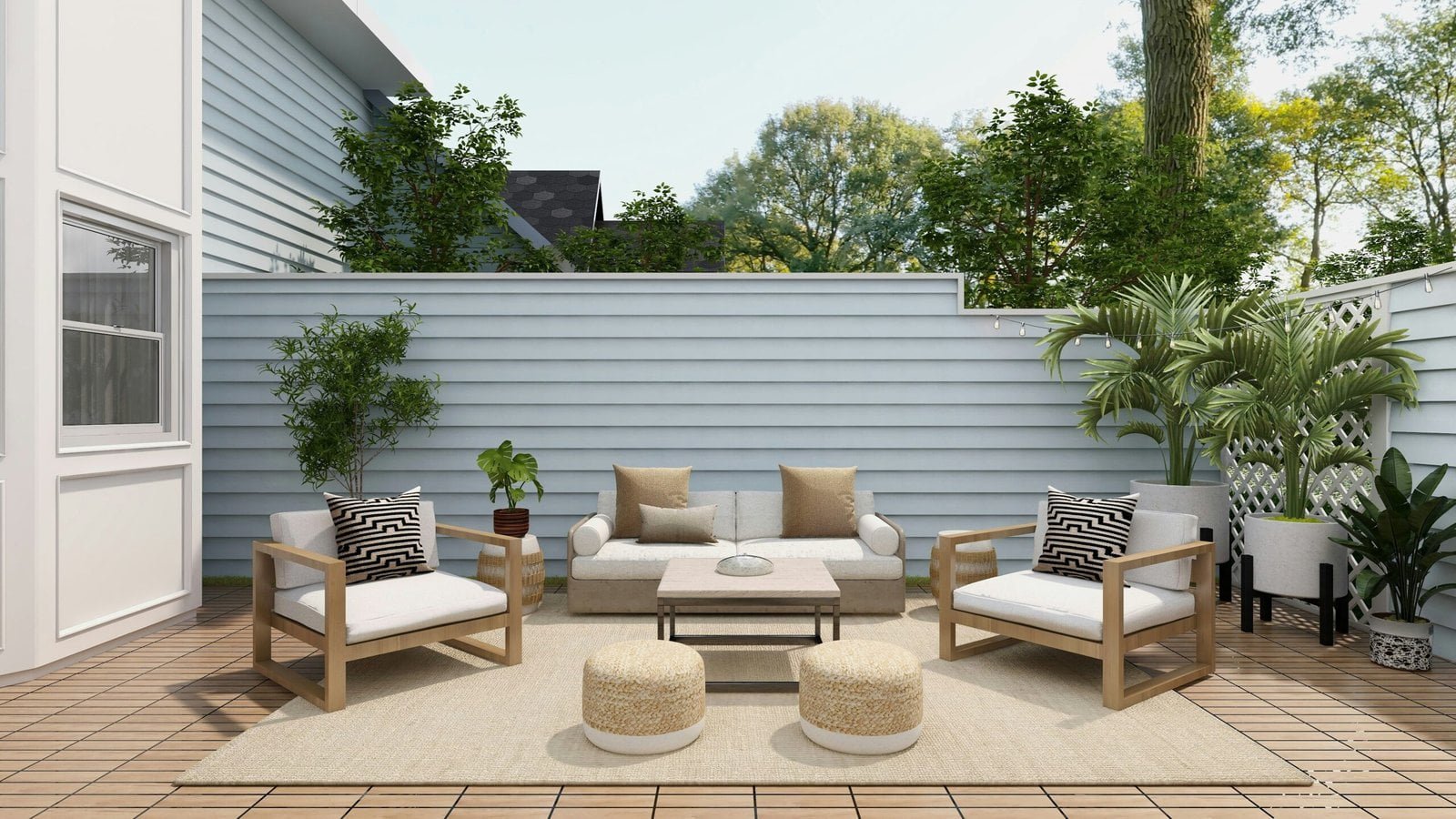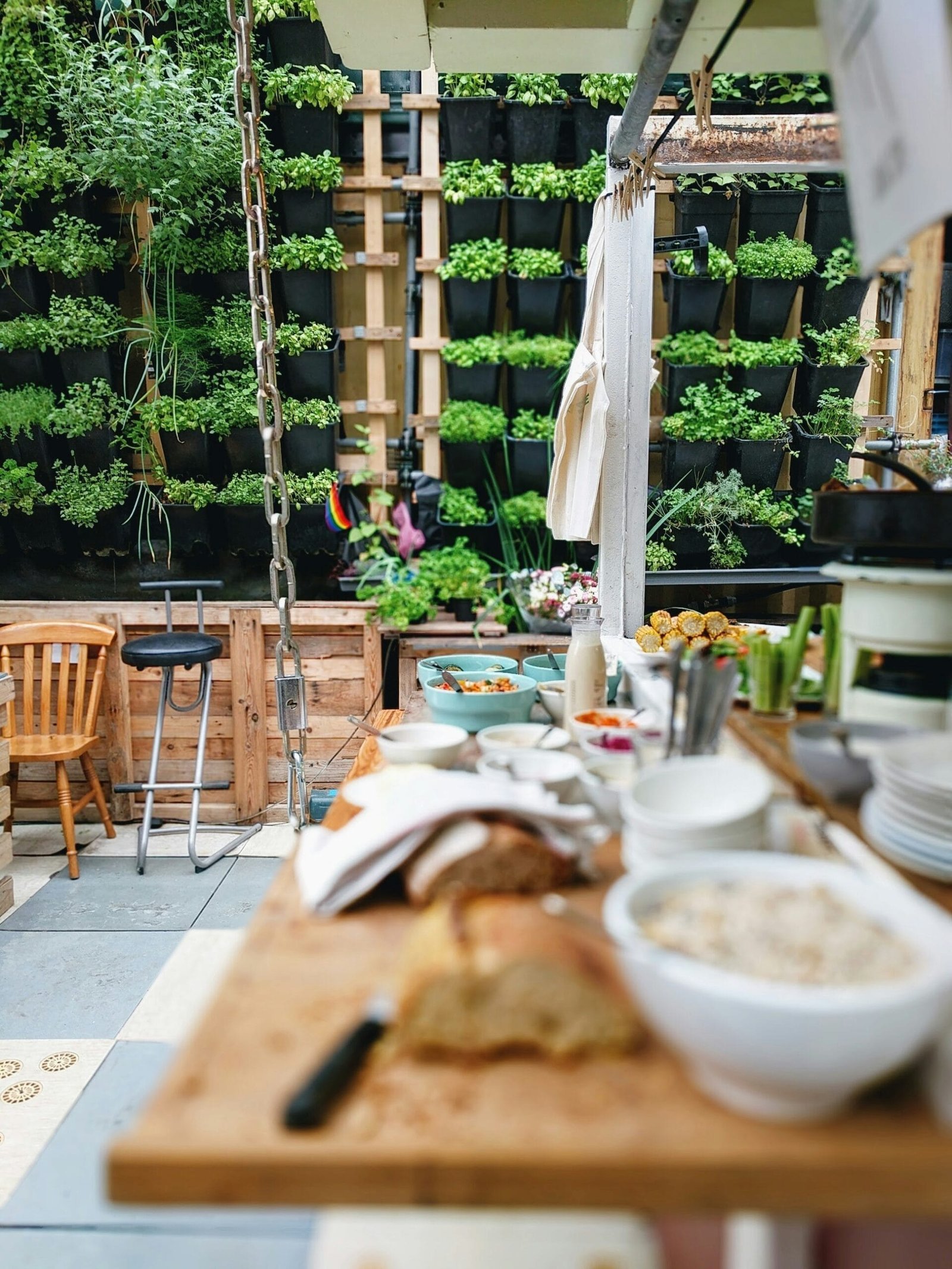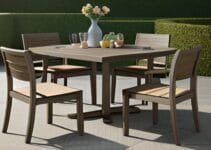Introduction: Why Paint Rusty Outdoor Furniture?
Outdoor furniture, often exposed to harsh weather conditions, is particularly susceptible to rust. This common issue not only degrades the aesthetic appeal of the pieces but also undermines their structural integrity. Rust, essentially the oxidation of metal, can lead to weakening and eventual breakdown of the material, posing a risk to both the furniture’s functionality and safety.

Please, read our post and do not forget to check our YouTube channel “Grig Stamate”:
https://www.youtube.com/@GrigStamate
You will find there, thousands of designing, furnishing, and decorating ideas for your home interior and outdoors.
Allow me to mention one of them:
Quick Small Patio Makeover | Outdoor Design Ideas (video)
Addressing rust on outdoor furniture is crucial for several reasons. Firstly, painting over rust can significantly extend the lifespan of the furniture. By creating a protective barrier, paint prevents further oxidation and shields the metal from additional damage. This proactive measure can save you from the inconvenience and expense of frequent replacements.
Secondly, painting rusty furniture can dramatically enhance its appearance. An unsightly layer of rust can make even the most stylish pieces look neglected and worn out. A fresh coat of paint revitalizes the furniture, restoring its original charm or even giving it a new, updated look. This transformation can rejuvenate your outdoor space, making it more inviting and visually appealing.
Furthermore, painting over rust is a cost-effective solution. Purchasing new outdoor furniture can be a considerable investment, especially if you own multiple pieces. By opting to repaint rather than replace, you can achieve a like-new appearance at a fraction of the cost. This method not only conserves resources but also aligns with sustainable practices by reducing waste.
In summary, painting rusty outdoor furniture is a practical and economical approach to maintaining and enhancing your outdoor living area. It addresses both the aesthetic and functional aspects, ensuring that your furniture remains both beautiful and durable. This guide will provide you with the essential steps and tips to effectively paint over rust, offering a straightforward solution to a common problem.
Gathering the Necessary Materials
Before embarking on your project to paint over rusty outdoor furniture, it is crucial to gather all the necessary materials and tools. This preparation ensures a smooth and efficient process, yielding professional results. Below is a comprehensive list of what you’ll need:
Rust Converter or Primer: A rust converter or primer is essential for treating rusted areas. It chemically transforms rust into a stable compound, providing a solid base for the paint. Choose a primer specifically designed for metal surfaces that offers rust-inhibiting properties.
Rust-Resistant Paint: Selecting the right paint is vital. Opt for rust-resistant paint designed for metal surfaces, as it provides long-lasting protection and durability. Whether you choose a brush-on or spray paint format, ensure it is suitable for outdoor use and can withstand various weather conditions.
Brushes or Spray Paint: Depending on your preference and the size of the furniture, you can use either paint brushes or spray paint. Brushes are ideal for detailed work and smaller items, while spray paint offers a smoother finish for larger surfaces. High-quality brushes or paint sprayers will yield better results.
Sandpaper: Sandpaper is necessary for preparing the surface by removing loose rust and creating a smooth finish. Different grits of sandpaper will be required, typically starting with a coarser grit to remove rust and finishing with a finer grit for smoothing.
Wire Brushes: Wire brushes are effective for scrubbing off rust and old paint. They come in various shapes and sizes, making them versatile tools for reaching nooks and crannies.
Drop Cloths: Protect your workspace with drop cloths to prevent paint splatters and debris from creating a mess. This is especially important if you’re working on a patio or driveway.
Protective Gear: Safety should always be a priority. Wear gloves to protect your hands from chemicals and rough surfaces, and use masks to avoid inhaling dust and fumes. Eye protection is also advisable when sanding or using spray paint.
By carefully selecting and preparing these materials, you set the foundation for a successful project. Ensuring you have the right type of paint and primer designed for metal surfaces will significantly enhance the durability and appearance of your outdoor furniture.
Before embarking on the process of painting over rusty outdoor furniture, it is crucial to meticulously prepare the surface to ensure a smooth and long-lasting finish. Proper preparation not only enhances the adhesion of the paint but also extends the lifespan of the refurbished furniture.
Cleaning the Furniture
The first step in preparation is thoroughly cleaning the furniture to eliminate dirt, debris, and loose rust. Begin by using a mild detergent mixed with water to scrub the surface. Employ a sponge or a soft brush to reach into crevices and corners. Rinse the furniture with clean water and allow it to dry completely. Removing all contaminants will prevent interference with the paint application later on.
Removing Rust and Smoothing Rough Areas
Once the furniture is clean and dry, the next step involves tackling the rust and any rough areas. Utilize sandpaper or a wire brush to scrub away as much rust as possible. Focus on heavily rusted spots first, using coarse sandpaper (around 80-grit) to break down the rust. For finer smoothing, switch to a medium-grit sandpaper (around 120-grit). Sand in a circular motion to ensure evenness. Wire brushes are particularly effective for getting into tight spots and removing rust from intricate designs.
Safety Precautions
While preparing the furniture, it is imperative to prioritize safety. Conduct the work in a well-ventilated area to avoid inhaling dust and fumes. Wearing appropriate protective gear is essential; this includes safety goggles to shield the eyes from debris, a dust mask to protect the respiratory system, and gloves to prevent skin contact with rust particles and cleaning agents. Proper safety measures ensure a safe and efficient preparation process.
By following these preparatory steps, you set a solid foundation for the painting process, ensuring that the final result is both aesthetically pleasing and durable. The meticulous removal of rust and thorough cleaning will significantly contribute to the overall success of your project.
Applying Rust Converter or Primer
A rust converter or primer serves a critical role in preparing your rusty outdoor furniture for a fresh coat of paint. It chemically transforms rust into a stable, paintable surface, thereby extending the life of your furniture and ensuring a more durable finish. Before starting, it is essential to select a high-quality rust converter or primer suitable for outdoor use.
To begin, thoroughly clean the rusty surface to remove any loose rust, dirt, and debris. Use a wire brush or sandpaper to scrub the area, followed by wiping it down with a damp cloth to ensure a clean, dry surface. This step ensures that the rust converter or primer adheres properly.
Next, shake or stir the rust converter or primer as per the manufacturer’s instructions to achieve an even consistency. Using a brush, roller, or spray applicator, apply the product evenly across the rusty surfaces. Ensure that you cover all areas, paying special attention to edges and crevices where rust tends to accumulate. It is advisable to apply a thin, uniform layer to prevent drips and runs.
Allow the product to dry thoroughly. Drying times can vary depending on the specific converter or primer used and the ambient conditions such as temperature and humidity. Typically, it may take anywhere from 24 to 48 hours. Refer to the manufacturer’s guidelines for precise drying times to ensure optimal results.
Applying a second coat may be necessary for heavily rusted areas. Follow the same procedure for the second coat, ensuring that the first coat is completely dry before reapplication. This step further solidifies the base, making it more receptive to the final paint layer.
Following the manufacturer’s instructions meticulously is paramount. These guidelines are tailored to the product’s chemical composition and are designed to maximize its effectiveness. Proper application of rust converter or primer not only enhances the adhesion of the paint but also contributes significantly to the longevity and aesthetic appeal of your outdoor furniture.
Painting the Furniture
Once your outdoor furniture is prepared and rust-free, the next crucial step is applying the paint. The choice between using brushes and spray paint depends on your specific needs and the nature of your furniture. Spray paint is often favored for its convenience and ability to cover large areas quickly and evenly. It also excels at reaching intricate details and hard-to-reach areas, making it a versatile option for furniture with complex designs. However, spray paint can be more challenging to control and may require a well-ventilated area to prevent inhalation of fumes.
On the other hand, using brushes offers greater control and precision, especially if you’re working with small or detailed pieces. Brushes allow for more deliberate application, which can be beneficial for achieving a smooth finish. However, it might be more time-consuming and could potentially leave brush marks if not done carefully.
Regardless of the method chosen, achieving an even coat is essential. Start by applying thin layers of paint rather than attempting to cover the furniture in one heavy coat. This approach not only prevents drips and runs but also ensures better adhesion and durability of the paint. Allow each layer to dry thoroughly before applying the next. This drying time can vary based on the type of paint used and environmental conditions but generally ranges from a few hours to overnight.
When painting intricate details or hard-to-reach areas, consider using smaller brushes or spray paint nozzles designed for precision. These tools help in ensuring that every nook and cranny is adequately covered without excess paint buildup. For added protection and a professional finish, consider applying a clear sealant after the paint has fully dried. This extra layer will help safeguard your work against the elements, ensuring your furniture remains vibrant and rust-free for an extended period.
Sealing and Protecting the Paint
Once the paint on your outdoor furniture has dried, the next crucial step is sealing and protecting it to prevent future rust and weather damage. Applying a sealant not only enhances the durability of the paint but also adds an extra layer of protection against moisture and UV rays, which are common culprits in the deterioration of outdoor furnishings.
Several types of sealants can be used for this purpose, each with its own set of advantages. Clear coats, for instance, are popular choices because they maintain the original color and finish of the paint. These can be either solvent-based or water-based, with solvent-based options usually providing a harder, more durable finish. Varnishes, on the other hand, come in various finishes, such as matte, satin, and gloss, allowing you to customize the look of your furniture while ensuring robust protection.
To apply a sealant correctly, start by ensuring the painted surface is completely dry. This typically means waiting at least 24 hours, although drying times can vary based on the type of paint and environmental conditions. Once dry, use a clean, dry brush or a spray applicator to apply a thin, even coat of the sealant. Be sure to cover all areas thoroughly, paying extra attention to joints, crevices, and edges where moisture can easily accumulate.
Allow the first coat of sealant to dry according to the manufacturer’s instructions, which is usually around 4 to 6 hours. After the initial coat is dry, lightly sand the surface with fine-grit sandpaper to ensure better adhesion for subsequent coats. Wipe away any dust before applying at least one more coat of sealant. Multiple coats are often recommended for maximum protection, especially for furniture that will be exposed to harsh weather conditions.
It’s important to let the painted and sealed furniture cure fully before using it. This curing process can take up to several days, depending on the products used and the climate. Rushing this step can compromise the protective qualities of the sealant, leading to premature wear and potential rust reformation. Patience in this stage will ensure your rejuvenated outdoor furniture remains in excellent condition for years to come.
After investing time and effort into painting over rust on your outdoor furniture, maintaining its pristine condition becomes paramount. Regular maintenance is the key to ensuring that rust does not reappear and that your furniture remains aesthetically pleasing and functional for years to come.
Regular Cleaning Routines
One of the most effective ways to prevent rust is through regular cleaning. Dirt, grime, and moisture are the primary culprits when it comes to rust formation. A simple routine of wiping down your furniture with a damp cloth followed by a dry one can make a significant difference. For a more thorough clean, use a mild soap solution, ensuring that all soap residue is rinsed off and the furniture is dried completely.
Using Protective Covers
Protective covers are an excellent investment for safeguarding your outdoor furniture against harsh weather conditions. During rainy or snowy seasons, these covers act as a barrier, preventing moisture from coming into direct contact with the metal surfaces. Always ensure that the covers are breathable to avoid condensation, which can also lead to rust.
Prompt Touch-ups
Even with the best care, occasional chips or scratches in the paint are inevitable. It is crucial to address these imperfections promptly. Touching up any damaged areas with a rust-inhibiting primer and matching paint can prevent rust from taking hold. Keeping a small supply of touch-up paint on hand can make this process quick and easy.
Proper Storage During Off-Seasons
Storing your furniture properly during off-seasons is another essential step in rust prevention. If possible, move the furniture to a dry, indoor location. If indoor storage is not an option, at least elevate the furniture off the ground and cover it securely. This minimizes exposure to moisture and fluctuating temperatures, both of which contribute to rust formation.
By incorporating these maintenance tips into your regular routine, you can keep your outdoor furniture looking fresh and rust-free, prolonging its lifespan and ensuring it remains a beautiful addition to your outdoor space.
Conclusion: Enjoying Your Refurbished Furniture
Painting over rust is an effective and rewarding way to breathe new life into your outdoor furniture. By following the steps outlined in this guide, you can transform rusty, weathered pieces into attractive, durable fixtures that enhance your outdoor space. The benefits of this undertaking extend beyond the aesthetic improvement; it also protects your furniture from further corrosion, prolonging its usability and ensuring you enjoy your investment for years to come.
Taking on this project can be incredibly satisfying. There’s a unique sense of accomplishment in seeing the transformation from rusty relics to vibrant, revitalized furniture. It’s an opportunity to express your creativity and personalize your outdoor environment to better reflect your style and preferences. Moreover, this endeavor can be a cost-effective alternative to purchasing new furniture, allowing you to allocate resources to other enhancements for your home or garden.
For those interested in diving deeper into furniture restoration, numerous resources and tutorials are available online. These can guide you through more advanced techniques such as metal welding, intricate paint designs, or even complete structural repairs. Engaging with these materials can further hone your skills and expand your repertoire of DIY projects, enabling you to tackle a broader range of restoration challenges.
We encourage you to embrace the project of refurbishing your outdoor furniture. Not only will it rejuvenate your patio or garden area, but it will also provide a fulfilling and creative outlet. Enjoy the process and take pride in your revitalized outdoor space, knowing that your effort has given your furniture a new lease on life.
Other related posts from our website:
https://howtobuildahouseblog.com/essential-tips-for-caring-for-wooden-outdoor-furniture/
https://howtobuildahouseblog.com/transforming-your-outdoor-kitchen-into-a-luxurious-oasis/
Thank you so much for your attention.
Stay tuned. We will upload many other amazing posts to our website and videos onto our YouTube channel.
Thank you so much.
for your time and attention.
Best Regards
See you to another post,
Bye, Bye


No Responses